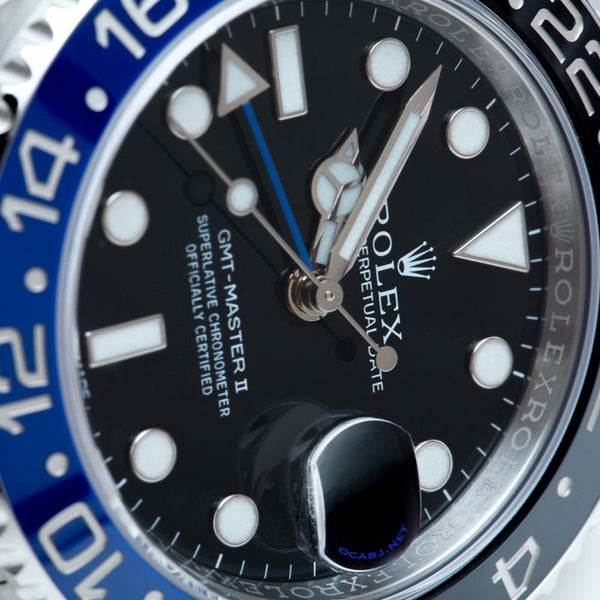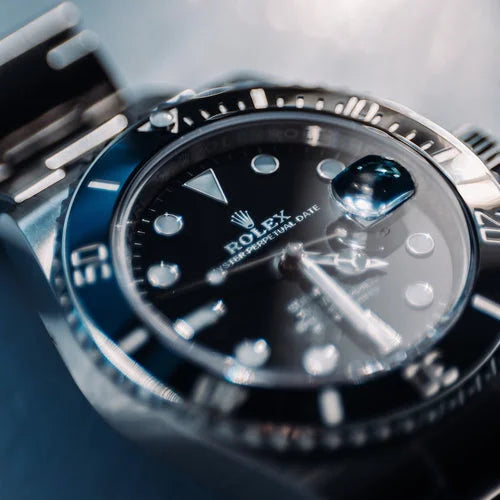How To Spot Real Vs. Fake Rolex Daytona Watch

Few names carry the same weight and prestige when it comes to luxury timepieces as Rolex. The Rolex Daytona, in particular, holds a special place in the world of horology, known for its rich history, technical prowess, and iconic design.
In this guide, we'll delve into the key features that distinguish a genuine Rolex Daytona from a counterfeit, helping you navigate the complexities of authentication in the realm of luxury watches.
Table of Contents
[ open ]Why the Rolex Daytona?
The Rolex Daytona isn't just any watch—it's a symbol of precision and style. First made for racing pros in 1963, it's named after the famous Daytona International Speedway. Its high-precision chronograph helps drivers measure time and speed accurately, a hit with motorsports fans.
Despite small changes over the years, the Daytona's design has stuck to its roots. This makes it an icon in the watch world, loved by collectors. But getting one isn't easy; it's rare and often faked.
Still, there's a reason for its high price. Rolex is known for top-quality craftsmanship, making a real Daytona a prized possession. Whether you're a racing fan or just love fine watches, the Daytona is a timeless classic.
Key Features of a Genuine Rolex Daytona
Here are the most important features of a genuine Rolex Daytona.
The Movement

When checking if a Rolex Daytona is real, start by looking at its movement, the watch's "heart." A genuine Daytona has the Caliber 4130 movement, which is known for its accuracy. Made in-house by Rolex, this self-winding mechanical movement has a built-in chronograph and a Parachrom hairspring for better precision. It can run for 72 hours on one wind.
Fake Daytonas might have lower-quality movements or copies of the Caliber 4130, like quartz movements, which Rolex doesn't use. Genuine Daytonas have flawless finishing and intricate details on the movement, setting them apart from rough or poorly made fakes.
Case and Craftsmanship
When checking a Rolex Daytona, focus on its case. Real Daytonas use high-quality materials like stainless steel, yellow gold, or Everose gold. They feel solid, with smooth edges and perfect finishing.
Find the Rolex crown symbol engraved between the lugs – a sign it's genuine. Fake ones might feel lighter with rough edges. The crown symbol may be poorly engraved or misaligned.
Authentic Daytonas have a serial number between the lugs at six o'clock. You can verify it with Rolex's records, boosting its authenticity.
You can use the same method to legit check Rolex Submariner watches.
Dial Authenticity

When you're looking at a Rolex Daytona, focus on the dial – it's key to spotting a fake. A genuine one has a flawless dial with sharp hour markers and hands.
Counterfeit Daytonas often have blurry markers and hands with less detail. Check for "ROLEX" and "DAYTONA" etched into the dial – fakes might use decals. On a real one, the minute and second tracks line up perfectly.
Also, look at the rehaut – it should have a smooth, even finish on a genuine watch. Pay attention to the dial color, too – a genuine "Panda" Daytona, for example, is warm white, not grayish.
Lastly, check the bezel fit – a real Rolex fits seamlessly with no gaps, ensuring it's water-resistant.
The Bracelet

When it comes to a Rolex Daytona, don't forget to check out its bracelet – it's vital for authenticity. A real Daytona has a solid, well-made bracelet crafted from top-notch materials like stainless steel or precious metals.
Counterfeit Daytonas might feel flimsy, with poorly made links and a different-looking clasp. Look for the Rolex crown symbol on the clasp of a genuine one – fakes might have incorrect details or be missing the logo.
Also, ensure the serial number is engraved on the clasp – it's a key verification point. Keep in mind that some counterfeiters may use genuine Rolex parts, but this is rare and hard to detect without expert help.
Engravings and Serial Numbers
Engravings are vital for confirming a Rolex Daytona's authenticity. Genuine Daytonas have clear and precise engravings without mistakes or inconsistencies. These markings are carefully placed and easy to read, confirming the watch's authenticity.
In contrast, fake Rolexes may have poorly done engravings that seem shallow or incorrect. Check for alignment problems with the engravings on the inner bezel and differences in font compared to a genuine Daytona.
Also, real Daytonas have "SWISS MADE" or "MADE IN SWITZERLAND" engraved on the dial at six o'clock, showing their Swiss origin and high-quality craftsmanship.
Spotting a Fake
Here's how to spot a fake Rolex Watch.
Weight and Feel
When determining the authenticity of a Rolex Daytona, the weight and feel are crucial factors to consider. Authentic Rolexes are made from top-notch materials and have a noticeable weight to them. In contrast, counterfeit watches may feel lighter and less substantial. Keep an eye on the weight and overall feel of the watch to spot any discrepancies in authenticity.
Price Too Good to Be True
If you're considering buying a Rolex Daytona, remember the saying, "you get what you pay for." If the price seems unusually low, it's probably fake. Genuine Daytonas usually cost thousands or even tens of thousands of dollars, depending on the model.
Be careful of deals that seem too good to be true—they often mean fake watches. And remember, selling or using fake Rolexes as real ones is against the law and can get you in serious trouble.
Common Mistakes to Avoid
When verifying a Rolex Daytona, avoid common errors. Don't rely on just one aspect; counterfeiters replicate everything. High prices don't guarantee authenticity; some inflate prices for fakes.
Watch out for misleading online photos and descriptions. Pay attention to small details like typos or unusual fonts. Take your time inspecting the watch. If uncertain, seek expert advice to avoid scams.
Tips for Buying a Genuine Rolex Daytona
When buying a Rolex Daytona, choose a trusted seller like an authorized Rolex dealer or certified pre-owned shop for genuine watches. They guarantee quality and authenticity, backed by Rolex's strict standards.
Before buying, research the prices of real Daytonas to avoid overpaying or falling for fake deals. Suspiciously low prices are often a sign of counterfeits.
If considering an online purchase, be cautious. Check the seller's reputation with reviews and ratings. Ask for detailed photos so that the watch can be inspected closely for authenticity.
When seeing the watch in person, look closely at details like the serial number and engraving quality. Confirm the serial number with Rolex's records to ensure authenticity.
Trust your instincts. If something seems off, it probably is. Buying a Rolex Daytona is a big investment, so make sure it's worth it by following these tips and buying from a reliable source. Remember, a genuine Daytona represents luxury, quality, and timeless style.
These tips are relevant for all luxury watches, including Rolex Datejust.
The Impact of Owning a Fake
Some argue owning a fake Rolex Daytona is okay if you like it and it works well. However, there are good reasons why having the real deal matters.
- Quality and durability: Real Rolexes are built tough with great materials and skillful workmanship, so they last. Fakes might not hold up as well and could break easily.
- Value: Genuine Rolexes keep their worth over time, making them a smart buy. Fakes don't hold any value and might even lose it.
- Legal troubles: Selling or using fake goods as real is against the law and can get you in serious trouble. Buying a fake Daytona supports illegal activities.
- Prestige and reputation: Rolex is a big name, and having a fake could hurt your image, especially among watch fans.
- Long-term expenses: Fakes often need many fixes or replacements, which adds up. Going for the real deal is usually cheaper in the long run.
FAQs
Here are the answers to some of the most popular questions online.
How Can I Tell if My Rolex Daytona Is Real?
Authentic Rolex Daytonas exhibit superior craftsmanship, precise engravings, and high-quality materials. Look for hallmarks of authenticity such as clear and legible serial numbers, flawless dial printing, and a smooth, sweeping secondhand movement. If in doubt, have the watch authenticated by a professional jeweler or Rolex expert.
Can a Fake Rolex Daytona Have a Genuine Movement?
While it's rare, counterfeiters may sometimes use genuine Rolex movements in fake watches. However, other components of the watch, such as the case, dial, and bracelet, may still betray its inauthenticity. Always examine the watch as a whole to determine its authenticity.
Are There Different Versions of the Rolex Daytona?
Yes, the Rolex Daytona has undergone several iterations and variations over the years, with changes in materials, design elements, and movement technology. Collectors often seek out specific models and reference numbers, each with its unique characteristics and appeal.
How Do I Care for My Rolex Daytona?
To maintain the integrity and value of your Rolex Daytona, it's essential to care for it properly. Avoid exposing the watch to extreme temperatures, moisture, or magnetic fields, as these can damage the movement and affect its accuracy. Regular servicing by a certified Rolex technician is also recommended to ensure optimal performance and longevity.
Conclusion
In conclusion, a Rolex authentication service requires careful examination and attention to detail.
To spot a fake Rolex Daytona:
- Closely examine the watch's movement. A genuine one will feature the in-house Caliber 4130 with a precise chronograph function.
- Another crucial step in spotting a fake Rolex Daytona is to check the case. Look for high-quality materials and well-aligned engravings and serial numbers. This scrutiny will help you avoid falling for a counterfeit.
- Pay attention to the dial, ensuring it has sharp hour markers, hands, and correct logo placements. Inspect the bracelet for solid construction and proper engraving.
- Always verify the weight, feel, and price, as these can help differentiate a genuine Rolex from a counterfeit.
By understanding the key features and characteristics of a genuine Rolex Daytona, such as movement, case construction, dial authenticity, and engravings, you can confidently identify authentic timepieces and avoid counterfeit replicas.
Remember to purchase from reputable sources, seek professional authentication when in doubt, and appreciate the timeless craftsmanship and heritage of the Rolex Daytona.











